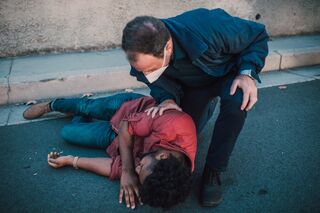Wisdom
How Often Do Victims of Street Violence Receive Help?
A cross-national study shows that intervention is the norm in public conflicts.
Posted April 10, 2021 Reviewed by Lybi Ma
Key points
- Contrary to conventional wisdom, people intervene and assist during conflicts that take place in public settings.
- Many bystanders are willing to intervene in and de-escalate hostile situations.
- The odds that a victim will receive help increases by 10 percent with each additional bystander nearby.

The recent spate of attacks on Asian Americans in cities around the United States has reinforced the popular belief that bystanders seldom intervene to help strangers, especially in densely populated urban areas. But is that belief correct?
Bystanders Do Not Stand By
A study published last year in the highly regarded journal American Psychologist found that, contrary to conventional wisdom, intervention is the norm in public conflicts. Research psychologist Richard Philpot at Lancaster University and his colleagues examined closed-circuit television (CCTV) footage of 219 public quarrels and attacks (Philpot et al., 2020). The incidents occurred on the street in the entertainment and central business districts of three cities: Amsterdam (the largest city in the Netherlands), Cape Town (the largest city in South Africa), and Lancaster (a smaller city in northwest England).
Philpot and his team trained four research assistants to count the number of bystanders at each incident and determine if one or more bystanders intervened in the public conflict. The conflicts ranged from animated disagreements to brutal attacks; the interventions ranged from calming gestures and separating individuals to physically pulling an attacker away from his victim. The assistants almost always agreed with each other when making their judgments.
In the footage of one incident, for example, a man can be seen beating another man who is down on the ground. Four persons are nearby when the attack begins. One bystander, a man, moves to pull the attacker away from his target. Another bystander, a woman, steps between the attacker and his victim, extending her arms to keep them at a distance from each other.
In their analysis, the researchers determined that at least one bystander intervened to help in 91 percent of the incidents. In fact, usually more than one person intervened; the average number of interveners per incident was 3.76.
More Bystanders Means More Intervention
The number of bystanders at the scene was positively associated, in a statistical sense, with the overall likelihood that someone would intervene. Specifically, the odds that a victim would receive help increased by 10 percent with each additional bystander. (The old adage “there’s safety in numbers” takes on new meaning.)
The pattern of interventions did not differ significantly across the three cities. Victims in Cape Town were as likely to receive help as victims in Amsterdam or Lancaster. (Interestingly, perceptions of public safety are considerably lower in Cape Town than in Amsterdam and Lancaster, which serves as a helpful reminder that our perceptions of reality do not always correspond with reality itself.)
The researchers noted that their study had certain limitations. First, because the videos did not have an audio track, the coders were not able to record verbal interventions such as “calm down” or “I’m calling the police.” The total number of interventions may have been higher than what was seen on the CCTV footage.
Second, the quarrels and attacks occurred in urban districts that had many restaurants, bars, and clubs. Some bystanders may have been tipsy from drinking alcohol, which could have affected their assessment of the risks involved. That is, some bystanders may have helped because they weren’t thinking clearly about the potential dangers associated with intervening in a violent attack. If that was the case, then rates of helping might be somewhat lower in shopping and residential districts.
Citizens Are Prepared to “Self-Police” Public Conflicts
The researchers also considered the policy implications of their findings. Many of the bystanders in their study were willing to intervene and tried to de-escalate a hostile situation before the police arrived. It seems that, in at least some circumstances, citizens are prepared to “self-police” public conflicts—an observation that has interesting implications for policing strategies and law enforcement budgets.
According to Philpot’s study, intervention is the rule, not the exception, in public conflicts. “We found that in nine-out-of-ten conflicts at least one person—but typically several—did something to help” (Philpot et al., 2020, p. 71). And that, my friends, is what we call good news.
References
Philpot, R., Liebst, L. S., Levine, M., Bernasco, W., & Lindegaard, M. R. (2020). Would I be helped? Cross-national CCTV footage shows that intervention is the norm in public conflicts. American Psychologist, 75, 66-75.


